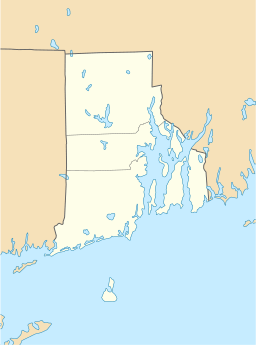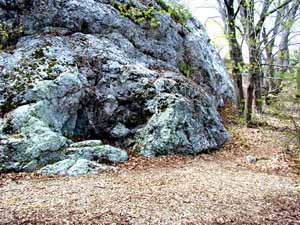Mount Hope (Rhode Island) facts for kids
Quick facts for kids Mount Hope |
|
|---|---|
| Montaup | |
| Highest point | |
| Elevation | 63.7 m (209 ft) |
| Geography | |
| Location | Bristol, Rhode Island, United States |
Mount Hope, originally called Montaup by the Pokanoket people, is a small hill in Bristol, Rhode Island. It looks out over Mount Hope Bay, which is part of Narragansett Bay. This hill is the highest point in Bristol County, Rhode Island. It stands 209 feet tall and drops steeply towards the bay on its east side. Long ago, Mount Hope was home to a Wampanoag (Pokanoket) village. It is famous for its important part in King Philip's War.
Mount Hope Today
Today, Brown University owns about 376 acres of woodland on Mount Hope. This land is off Tower Street in Bristol. On the university's property, you can find "King Philip's Seat." This is a large rock formation made of quartz. It was a special meeting place for the Wampanoag leader King Philip. The spot where King Philip died in Misery Swamp is also nearby. Mount Hope Farm is another important place close by.
King Philip's War
The first battle of King Philip's War happened near Mount Hope in 1675. By the mid-1600s, European settlers were taking more and more land. This reduced the land of the Pokanoket people to what was called the Mount Hope Lands.
After his father Massasoit and older brother died, Metacomet became the leader. He was known as King Philip. He started to make alliances with other Native American tribes. Soon, a war began. King Philip used Mount Hope as his main base. "King Philip's Chair," a rocky spot on the mountain, was a lookout point. From there, they could watch for enemy ships on Mount Hope Bay.
King Philip was eventually defeated and killed. In 1676, Captain Benjamin Church's men killed King Philip. This happened in the nearby Misery Swamp. A road in Bristol, State Route 136, is named Metacom Avenue after him. This name comes from his Wampanoag name, Metacomet.
Early European Settlement
After King Philip's War ended, the area around Mount Hope was settled in 1680. It became part of the Plymouth Colony. In 1680, four investors from Boston bought all 7,000 acres of the Mount Hope Lands. This land became the Town of Bristol.
One of the investors, Nathaniel Byfield, claimed 550 acres of Mount Hope for his own farm. He sold the farm to his son-in-law in 1702. Later, in 1744, Byfield's granddaughter, Elizabeth Royall, inherited it. Elizabeth and her husband Isaac built a large house on the farm. This house is still part of the farm today.
Bristol remained part of Massachusetts until 1747. That year, the Crown (the British government) transferred Bristol and other lands to the Rhode Island Colony. During the American Revolutionary War, Elizabeth and Isaac were Loyalists. This meant they supported the British King. They had to leave Bristol, and the State of Rhode Island took their home and farm.
Mount Hope Farm Today
After the Revolutionary War, William Bradford bought Mount Hope Farm. He was a great-great-grandson of Governor William Bradford. William Bradford had been a public servant for many years. He served as Lt. Governor and a Senator for Rhode Island. The house built in 1745 on Mount Hope Farm is still called The Governor Bradford House.
Today, the 127-acre Mount Hope Farm is run by the Mount Hope Trust. This is a non-profit organization. They offer 12 rooms for people to stay in. The buildings and grounds can be rented for events. They also offer many community and children's programs.
Mount Hope can also be seen as part of the Haffenreffer Museum of Anthropology grounds. Interestingly, Captain Benjamin Church, who was involved in King Philip's death, later became an owner of Mount Hope.




